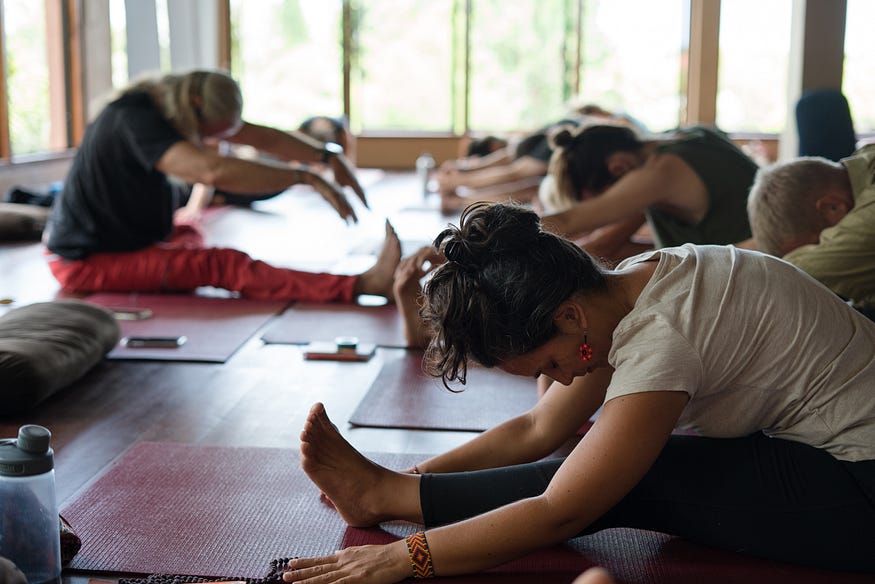In every body and every cell, the intelligence of the male-female mutuality is present. What is the simplest way to experience it? With our breath. Breathing, pranayama, is how we release ingrained patterns and clear the mind. Asana practice is just moving breathing.
Too many popular yoga “brands,” however, have traveled very far indeed from this simple mutuality. So, rather than talk too much about specific postures here, I’m going to give you the foundation of all asana. Ready? Your breath will be the guru that guides you through your yoga practice. The body movement is the breath movement, so always begin the breath before you move. In yoga we use the ujjayi breath, which is the same full-body breath we use in sleep. We inhale and exhale through the nose, but the breath is controlled at the throat, producing a sound with a low and uniform pitch. Most people have a strong exhale, but it’s important to practice inhaling with the same quality. In order to learn how to receive, you need a strong, soft inhale, smooth and equal in length to your exhale.
Try inhaling a strong, smooth ujjayi breath as you raise your arms and look up at your hands, keeping the shoulders relaxed. Exhale an even breath and bring the arms down again. After the first breath, try another. The first two breaths may be difficult, but the third comes sweetly. Inhale and receive God. Pause and be with God. Exhale and surrender to God. Pause after exhaling. You are surrendered. When you consciously participate in your own breath, you are connecting directly to That which is breathing you — and beating your heart and all the rest.
The breath is the key to making your yoga practice personal to you. Yoga-realization is the realization of you as Life itself, in the midst of the cosmos and in utter intimacy with the cosmos. It all happens in your body, so just as your life is your own, your asana, breathing and relationships must be your own. Work with a teacher you trust, and do the yoga that’s right for your body, rather than forcing your breath into line with someone else’s standard practice. The appropriateness of the postures lies not in the look of your body as you do them, but in the feeling they create within you.
Before coming together, you and your partner can use the breath to be present with yourselves. Receive your inhalation through a soft body, in strong postures that are right for you. Practice for a few weeks, twenty minutes a day, with no expectations, no goals. Then you will spontaneously receive each other, in the context of breathing, living, relating. In an endless cycle of feeling, you love with your body and merge with your lover: the Two become One.
Just remember that the yoga of relationship is much more than a theory, idea or good intention. It is the physical practice of body and breath by both partners that makes it possible. It is a very real change of patterning from negative to positive, so it requires attention. Whatever is happening, do the discipline of body, breath, touch and loving, even for a brief time. The mind can be troubled by all kinds of things that may or may not be relevant to the relationship. But the body is senior to the mind, and the life energy that flows from your yoga will inform the mind of life’s fundamental intelligence.
Like sex, breath is a natural function of life that we cannot suppress without damage. The same way that you love to dance, love to love, learn to love to breathe. Breathe to feel your intimacy with your partner and with yourself. Breathe to feel how you love and are loved, heal and are healed. Breathe to embrace the opposites in your body and in your life, and feel the current of all life run through you.
Read more about Yoga or visit here to learn more
Mark Whitwell has been teaching yoga around the world for many decades, after first meeting his teachers Tirumali Krishnamacharya and his son TKV Desikachar in Chennai in 1973. Mark Whitwell is one of the few yoga teachers who has refused to commercialise the practice, never turning away anyone who cannot afford a training. The editor of and contributor to Desikachar’s classic book “The Heart of Yoga,” Mark Whitwell is the founder of the Heart of Yoga Foundation, which has sponsored yoga education for thousands of people who would otherwise not be able to access it. A hippy at heart, Mark Whitwell successfully uses a Robin Hood “pay what you can” model for his online teachings, and is interested in making sure each individual is able to get their own personal practice of yoga as intimacy with life, in the way that is right for them, making the teacher redundant. Mark Whitwell has been an outspoken voice against the commercialisation of yoga in the west, and the loss of the richness of the Indian tradition, yet gentle and humorously encouraging western practitioners to look into the full depth and spectrum of yoga, before medicalising it and trying to improve on a practice that has not yet been grasped. And yet Mark Whitwell is also a critic of right-wing Indian movements that would seek to claim yoga as a purely hindu nationalist practice and the intolerant mythistories produced by such movements. After encircling the globe for decades, teaching in scores of countries, Mark Whitwell lives in remote rural Fiji with his partner, where Mark Whitwell can be found playing the sitar, eating papaya, and chatting with the global heart of yoga sangha online. Anyone is welcome to come and learn the basic principles of yoga with Mark Whitwell.


Comments
Post a Comment